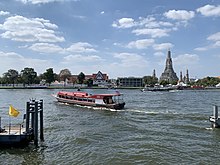River systems of Thailand

Thailand has 22 river basins with 254 sub-basins. Rainwater is one of the most important sources of water. Thailand's water resource per capita is less than that of other countries in the region.[1]
The two principal river systems of Thailand are the Chao Phraya and the Mekong. Together, these rivers support the irrigation for Thailand's agricultural economy.
In addition to these two large systems, there are a number of other river systems and individual rivers which drain the lands within Thailand's borders into the Gulf of Thailand and the Andaman Sea. One-third of the nation's rivers flow into the Mekong.[1] The Mekong is the only river system in Thailand which drains into the South China Sea.
Chao Phraya River system


The Chao Phraya River system is the main river system of Thailand, as its basin defines much of the region of central Thailand. The
In
Tributaries
The principal tributaries of the Chao Phraya River are the Pa Sak River, the Sakae Krang River, the Nan River (along with its principal confluent the Yom River), the Ping River (with its principal confluent the Wang River), and the Tha Chin River.[3] Each of these tributaries (and the Chao Phraya itself) is further tributed by additional minor tributaries often referred to as khwae. All of the tributaries, including the lesser khwae, form an extensive tree-like pattern, with branches flowing through nearly every province in central and northern Thailand.[3]
None of the tributaries of the Chao Phraya extend beyond the nation's borders.
Drainage
The expanse of the Chao Phraya River and its tributaries, i.e., the Chao Phraya river system, together with the land upon which falling rain drains into these bodies of water, form the Chao Phraya watershed.[5] The Chao Phraya watershed is the largest in Thailand, covering approximately 35 percent of the nation's area, and draining an area of 157,924 square kilometres (60,975 sq mi).[6]
Lesser Gulf river systems
There are numerous rivers which flow into the Gulf of Thailand, including a number of west coast gulf rivers, east coast gulf rivers, and rivers which drain into the gulf on the east coast of the Malay Peninsula. The following river systems, in addition to the Chao Phraya, are the most significant gulf systems in Thailand:
Bang Pakong
The
Phetchaburi
The
Mae Klong
The
Pran Buri
The
Khlong Kui
The
Tapi and Phum Duang
The
Pattani
The Pattani River is the longest of all Thai rivers on the Malay Peninsula with a total length of 214 kilometres (133 mi).
Mekong River system
The
From the
The river forms the border between Myanmar and Laos for 200 kilometres (120 mi), at the end of which it meets the tributary Ruak River at the Golden Triangle. This point also marks the division between the Upper and Lower Mekong.
The river then divides Laos and Thailand, before a stretch passing through Laos alone. It is called Maenam Khong in both Lao and Thai (แม่น้ำโขง). The river again marks the Lao-Thai border in the stretch which passes Vientiane, followed by a short stretch through Laos alone.
In Cambodia, the river is called the Mékôngk or Tonle Thom ("great river"). Just above
Thai tributaries of the Mekong
The following are the principal
- Ruak River (joins the Mekong in Thailand)
- Kok River (joins the Mekong in Thailand)
- Ing River (joins the Mekong in Thailand)
- Mun River (joins the Mekong in Thailand)
- Chi River (joins the Mun in Thailand)
- Lam Dom Noi (joins the Mun in Thailand)
- Lam Takhong (joins the Mun in Thailand)
- Tonlé Sap River (joins the Mekong in Cambodia, but extends into Thailand)
Drainage
The Mekong drains a considerable portion of northeast Thailand. In terms of Thai territory drained, it is second only to the Chao Phraya system.
Salawin River System
The
Thai tributaries
The principal tributaries of the Salawin which flow through Thailand are the Moei River and the Pai River.
Other Andaman Sea rivers
In addition to the Salween River, there are a number of rivers which drain into the Andaman Sea from the west coast of the Malay Peninsula. None of them are extensive enough to be considered river systems.
References
- ^ a b THAILAND ENVIRONMENT MONITOR Integrated Water Resources Management: A Way Forward (PDF) (63368 ed.). The World Bank. June 2011. Retrieved 26 November 2016.
- .
- ^ a b c Royal Irrigation Department River Gauges Report Archived 2009-08-14 at the Wayback Machine
- ^ Google Earth
- ^ River and Watershed Facts on the Chao Phraya
- ^ Basins of Thailand Archived 2008-02-22 at the Wayback Machine
- ^ Source of the Mekong River (Langcang Jiang)
- ^ "Tibetan Ecology Foundation-Khoryug". Archived from the original on 20 April 2012. Retrieved 25 April 2012.
